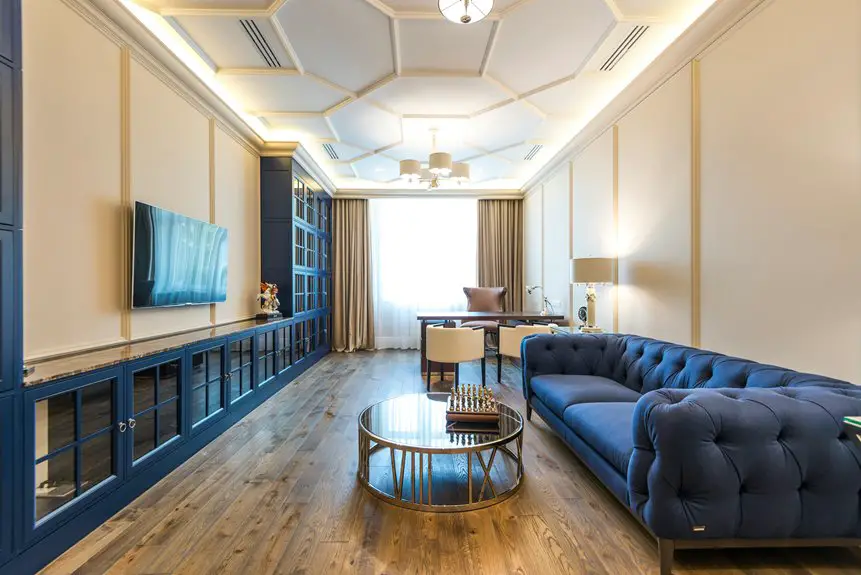When it comes to quality desks, their lifespan can vary significantly based on materials and construction. You might be surprised to learn that solid wood desks, if cared for properly, can last for decades. However, not all desks are created equal, and factors like maintenance and design play a crucial role. So, how do you ensure your desk stands the test of time? Let's explore what truly influences a desk's longevity.
Table of Contents
Key Takeaways
- Solid wood desks can last for decades, especially when made from hardwoods like oak or maple and maintained properly.
- Metal desks typically have a lifespan of 15 to 30 years, depending on construction quality and materials used.
- High-quality finishes on wooden desks protect against scratches and moisture, extending their lifespan significantly.
- The average lifespan of particleboard or MDF desks is shorter, often requiring replacement within a few years.
- Regular maintenance, such as cleaning and proper weight distribution, can significantly prolong the life of any desk type.
Understanding Desk Materials and Their Lifespan
When you choose a desk, it's essential to consider the materials used, as they directly impact longevity and durability.
Solid wood desks, for example, offer excellent strength and can last for decades with proper care. If you're looking for something more budget-friendly, particleboard or MDF might suit your needs, but be aware these materials often have shorter lifespans.
Metal desks provide sturdiness and resistance to wear, making them ideal for heavy usage. Additionally, laminate surfaces can mimic wood while offering scratch resistance, but they may not hold up as well under stress.
Ultimately, understanding these materials helps you make an informed decision, ensuring your desk meets your needs for years to come. Choose wisely to maximize your investment!
The Impact of Desk Construction Quality
While the materials of a desk play a crucial role in its longevity, the quality of its construction can significantly influence its overall durability and stability.
When you choose a well-constructed desk, you're investing in features like sturdy joints, solid fastenings, and precise assembly techniques. These elements work together to prevent wobbling and ensure that your desk can withstand daily use without falling apart.
Additionally, a meticulously constructed desk often includes reinforcements that add to its strength, making it less susceptible to wear over time.
On the other hand, poorly constructed desks might save you money upfront but could lead to frustration and replacement costs down the line.
Ultimately, investing in quality construction pays off in long-term performance.
Average Lifespan of Different Types of Desks
When choosing a desk, you should consider how long it'll last based on its material.
Wooden desks often offer great durability, while metal desks tend to have impressive longevity.
Understanding these differences can help you make an informed decision that fits your needs.
Wooden Desks Durability
Understanding wooden desks' durability is crucial if you want to invest in a piece that lasts. The lifespan of a wooden desk can vary based on the type of wood and construction quality.
Here are three key factors to consider:
- Hardwood vs. Softwood: Hardwood desks (like oak or maple) typically last longer than softwood options (like pine).
- Finish Quality: A high-quality finish protects the wood from scratches and moisture, extending its lifespan.
- Maintenance: Regular care, such as polishing and cleaning, can significantly enhance durability.
When you choose a well-crafted wooden desk, you're not just investing in a piece of furniture; you're securing a long-lasting workspace that can withstand the test of time.
Metal Desks Longevity
If you're considering a metal desk, you'll be pleased to know that they often boast impressive longevity. Typically, metal desks can last anywhere from 15 to 30 years, depending on the quality of materials and construction.
Unlike wooden desks, they resist warping, scratching, and excessive wear, making them ideal for high-traffic areas. You'll find that powder-coated finishes also enhance durability while offering various aesthetic options.
When properly maintained, metal desks can withstand the rigors of daily use, making them a smart investment. Additionally, their sturdiness can support heavy equipment without sagging.
Factors Affecting Desk Durability
While a desk may seem like a simple piece of furniture, several factors significantly influence its durability.
When you're choosing a desk, consider these key elements:
- Material Quality: Desks made from high-quality wood or metal usually last longer than those made from cheaper materials.
- Construction Method: Desks that are well-constructed with proper joinery and reinforcements can withstand daily wear and tear far better than those that are poorly assembled.
- Weight Capacity: Understanding the desk's weight limit is crucial. Overloading can lead to structural damage and shorten its lifespan.
Maintenance Tips for Prolonging Desk Life
To keep your desk in top shape, regular cleaning is essential.
Make sure you distribute weight evenly to prevent unnecessary stress on any part of the surface.
These simple practices can significantly extend the life of your desk.
Regular Cleaning Practices
Since a clean desk not only looks better but also enhances your productivity, adopting regular cleaning practices is essential for prolonging its life.
Here are three simple steps to keep your desk in top shape:
- Dust Regularly: Use a microfiber cloth to wipe down surfaces weekly, removing dust and debris that can scratch or damage finishes.
- Clean Spills Immediately: If you spill something, clean it up right away to prevent stains or water damage. Use a gentle cleaner suitable for your desk material.
- Organize and Declutter: Spend a few minutes each week sorting through papers and items. Keeping your desk organized not only looks good but also prevents wear from unnecessary clutter.
Appropriate Weight Distribution
Proper weight distribution on your desk can significantly extend its lifespan and maintain its structural integrity. To achieve this, place heavier items, like printers or books, toward the center of the desk. This prevents unnecessary stress on the edges and corners.
Avoid overloading shelves or drawers, as excessive weight can lead to sagging or breakage. Regularly reassess your desk setup; shift items to ensure an even distribution.
Organizing your workspace not only enhances aesthetics but also protects your desk from damage. If you're using accessories, like monitors, invest in sturdy stands to distribute weight evenly.
Signs Your Desk Needs Replacement
When you start noticing cracks, wobbling, or an uneven surface on your desk, it might be time to consider a replacement. A desk plays a crucial role in your workspace, so keeping an eye on its condition is essential.
Here are some signs that indicate it's time for a new desk:
- Stability Issues: If your desk wobbles or feels unstable, it can lead to distractions and discomfort while working.
- Visible Damage: Cracks, dents, or peeling laminate not only look unprofessional but can affect functionality.
- Insufficient Space: If your desk no longer accommodates your work needs, it may hinder productivity.
Don't ignore these signs—upgrading your desk can enhance your workspace experience significantly.
Making an Informed Desk Purchase Decision
Before you dive into buying a new desk, it's crucial to assess your specific needs and workspace requirements.
Consider how much surface area you need for your tasks and the overall dimensions that fit your space. Think about your work style; do you require storage solutions or a minimalist design?
Pay attention to materials—solid wood is durable, while engineered wood can be cost-effective. Don't forget ergonomics; a desk at the right height can significantly impact comfort.
Set a budget that reflects quality without sacrificing essential features. Finally, read reviews and compare options to ensure you're making an informed decision.
This way, you'll end up with a desk that enhances your productivity and lasts for years.
Frequently Asked Questions
What Are the Best Brands for Durable Desks?
When you're searching for durable desks, consider brands like Herman Miller, Steelcase, and IKEA. They offer quality materials and designs that withstand daily use, ensuring your workspace remains functional and stylish for years to come.
How Can I Identify a Quality Desk When Shopping?
When you're shopping for a quality desk, look for solid materials, sturdy construction, and smooth joints. Check for weight and stability, and don't forget to consider your ergonomic needs for long-term comfort and productivity.
Are There Eco-Friendly Desk Options Available?
Yes, there are plenty of eco-friendly desk options available. You can find desks made from reclaimed wood, bamboo, or recycled materials. Look for brands that prioritize sustainability and environmentally friendly manufacturing practices when shopping.
Can a Desk Be Repaired if Damaged?
Yes, you can often repair a damaged desk. Depending on the type of damage, consider using wood glue, replacing hardware, or refinishing surfaces. With some effort, you can restore it to its former glory!
What Styles of Desks Last the Longest?
When choosing a desk, consider solid wood or metal styles; they tend to last longer. Avoid particleboard or flimsy designs. Investing in quality materials ensures durability, helping you create a lasting workspace you'll love.




